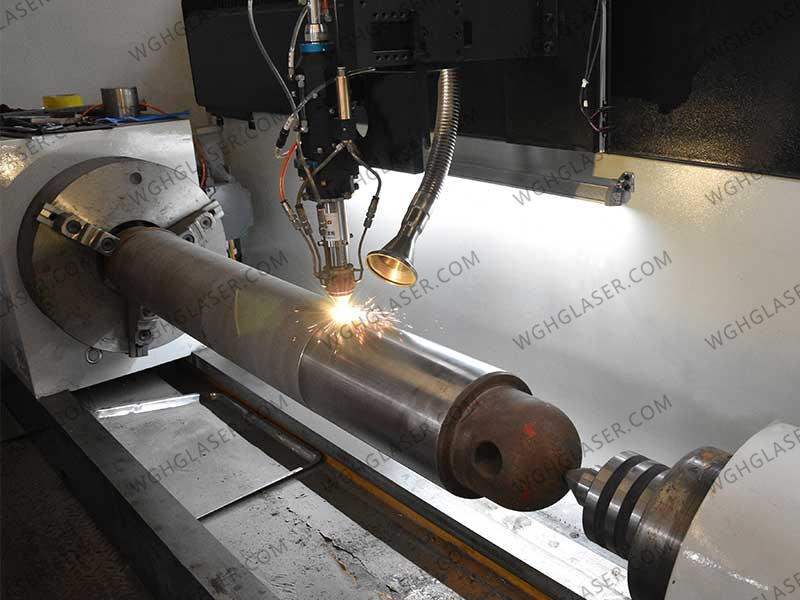What are the advantages of laser cladding?
I believe everyone is familiar with the laser cladding equipment. It is a new surface modification technology that adds cladding materials to the surface of the substrate, and then melts the surface of the high-energy density laser, and has a surface on the surface of the base layer. Also metallurgical filling equipment. So what characteristics does it have? Let’s take a look.
 Traditional solid-state lasers are usually pumped by high-power gas discharge lamps, with a pumping efficiency of about 3% to 6%. The large amount of energy emitted by the pump lamp is converted into heat energy, which not only causes the solid-state laser to adopt a bulky cooling system, but also causes the thermal lens effect that cannot be eliminated by the working material, thereby degrading the beam quality. And the life of the pump lamp is about 400 hours, so the operator needs to spend a lot of time to change the lamp frequently. If the system is interrupted, the efficiency of the automated production line will be greatly reduced. Compared with traditional lamp-pumped lasers, solid-state lasers (fiber lasers, disc lasers, diode lasers) have the following advantages:
Traditional solid-state lasers are usually pumped by high-power gas discharge lamps, with a pumping efficiency of about 3% to 6%. The large amount of energy emitted by the pump lamp is converted into heat energy, which not only causes the solid-state laser to adopt a bulky cooling system, but also causes the thermal lens effect that cannot be eliminated by the working material, thereby degrading the beam quality. And the life of the pump lamp is about 400 hours, so the operator needs to spend a lot of time to change the lamp frequently. If the system is interrupted, the efficiency of the automated production line will be greatly reduced. Compared with traditional lamp-pumped lasers, solid-state lasers (fiber lasers, disc lasers, diode lasers) have the following advantages:
1. High conversion efficiency: Because the emission wavelength of the semiconductor laser matches the absorption peak of the solid laser working material, and the pump light mode matches the laser oscillation mode, the light conversion efficiency is very high, reaching more than 50%. The efficiency of the whole machine can also be comparable to that of a carbon dioxide laser, which is an order of magnitude higher than that of a lamp-pumped solid-state laser, so the diode-pumped laser is small in size, light in weight and compact in structure.
2. Reliable performance and long life: The life of laser diode is much longer than flash lamp, up to 15,000 hours. The pump light has good energy stability, which is an order of magnitude better than flash lamp pumping. Its performance is reliable. It is a fully solidified device. It is a laser that does not require maintenance until now, and is especially suitable for large-scale production lines.
3. Good output beam quality: Due to the high conversion efficiency of the diode pumped laser, the thermal lens effect of the laser working material is reduced, and the output beam quality of the laser is greatly improved, resulting in the laser beam quality approaching the limit.
4. Fast speed, large depth, no deformation, no slag inclusion in the cladding layer, fine molten pool without pores.
5. It can work at room temperature or under special conditions. For example, the beam will not be deflected after the laser passes through the magnetic field, and it can be used even in a vacuum. It is cladding through glass and transparent materials.
6. Thin-walled laser cladding can be performed, and the substrate has no deformation.
If the cladding materials include powder and base materials, which are highly reflective materials, fiber lasers and diode lasers are not suitable due to their own design characteristics. The disc laser is more suitable for welding (including cladding) and cutting materials with relatively high reflectivity.

1. High conversion efficiency: Because the emission wavelength of the semiconductor laser matches the absorption peak of the solid laser working material, and the pump light mode matches the laser oscillation mode, the light conversion efficiency is very high, reaching more than 50%. The efficiency of the whole machine can also be comparable to that of a carbon dioxide laser, which is an order of magnitude higher than that of a lamp-pumped solid-state laser, so the diode-pumped laser is small in size, light in weight and compact in structure.

2. Reliable performance and long life: The life of laser diode is much longer than flash lamp, up to 15,000 hours. The pump light has good energy stability, which is an order of magnitude better than flash lamp pumping. Its performance is reliable. It is a fully solidified device. It is a laser that does not require maintenance until now, and is especially suitable for large-scale production lines.
3. Good output beam quality: Due to the high conversion efficiency of the diode pumped laser, the thermal lens effect of the laser working material is reduced, and the output beam quality of the laser is greatly improved, resulting in the laser beam quality approaching the limit.
4. Fast speed, large depth, no deformation, no slag inclusion in the cladding layer, fine molten pool without pores.
5. It can work at room temperature or under special conditions. For example, the beam will not be deflected after the laser passes through the magnetic field, and it can be used even in a vacuum. It is cladding through glass and transparent materials.
6. Thin-walled laser cladding can be performed, and the substrate has no deformation.
If the cladding materials include powder and base materials, which are highly reflective materials, fiber lasers and diode lasers are not suitable due to their own design characteristics. The disc laser is more suitable for welding (including cladding) and cutting materials with relatively high reflectivity.